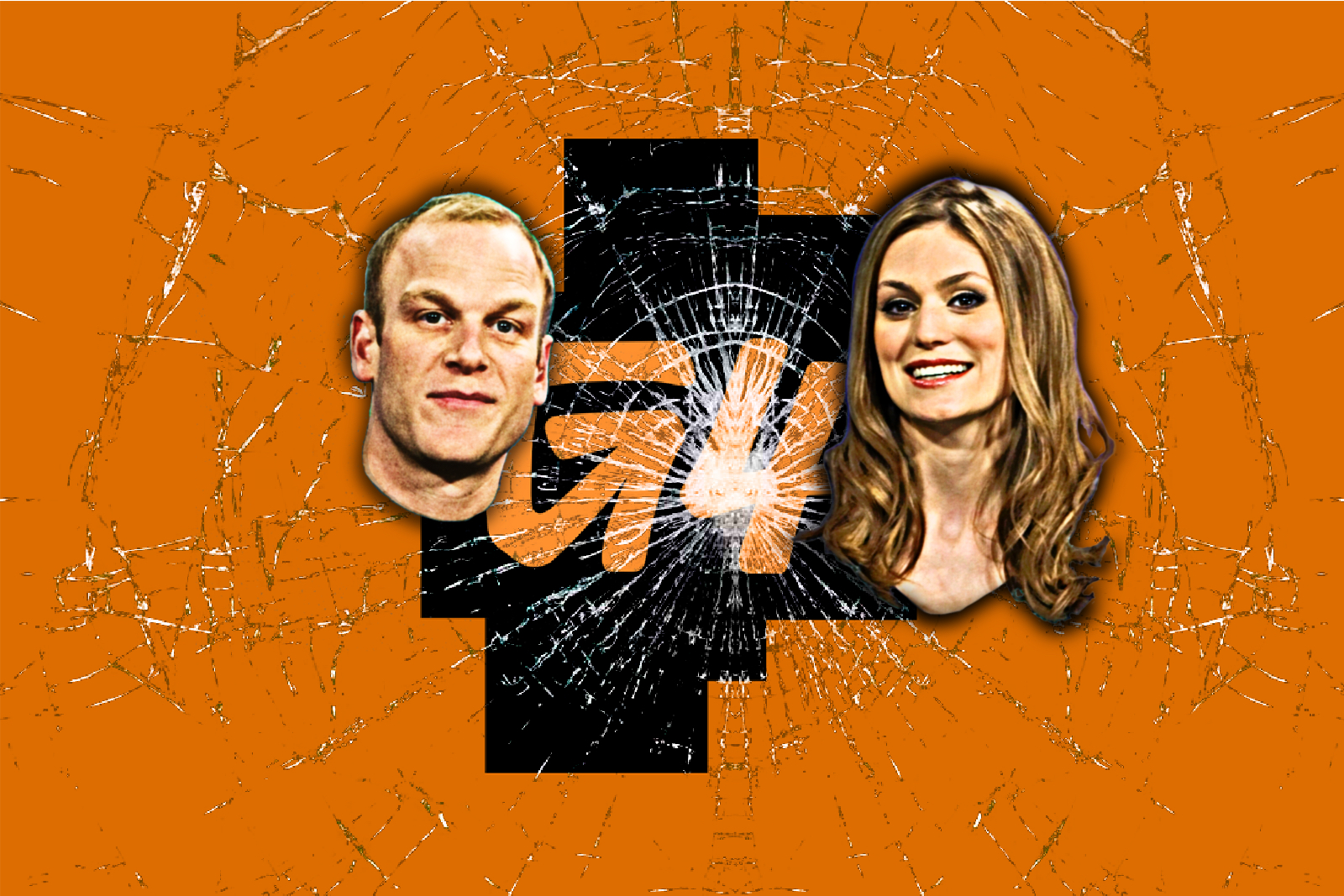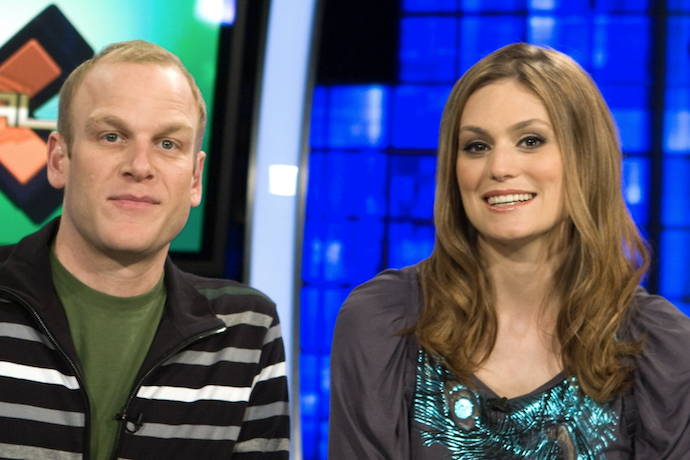
A Gaming Geek on the Failed Comeback of G4
It was an average day after school in 2005. I’m fourteen, I’ve just gotten off the bus, and don’t want to start my homework. I want to watch TV, so I turn on G4, the network dedicated to geekdom, video games, and gaming culture. I hear the announcer’s familiar voice exclaim “Today on X-Play!” X-Play was my favorite, it had an anarchic, quirky, subversive nature to it, which perfectly appealed to an eighth grader such as myself who was addicted to MAD Magazine. The two hosts, Adam Sessler and Morgan Webb, each brought a different presence: Adam, exuding older brother energy, was excited to share recent discoveries and reference nostalgic classics; Morgan was the girl next door who could beat just about anyone at multiplayer games.
They weren’t exactly the Siskel & Ebert of the video gaming world, but they played off of each other well, a mismatch of personalities that made each review, each episode its own unique thing. They, much like my beloved MAD Magazine did at the time, loved to riff recent events and pop culture. It’s 2005, and George W. Bush is an easy target. There were various skits and songs, and silly reoccurring characters like Ratty Handpuppet. Ratty’s whole deal was that he would appear, insult Adam and Morgan, scream “suck it!” and leave. My fourteen-year-old self thought it was the pinnacle of comedy.
But as many giggles or quotes to recite and go over with friends in the middle school cafeteria during lunch the next day as there were, there was also an underlying passion for video games. X-Play was harsh to video games that missed the mark, they sought only the best, most fulfilling experiences and had little patience for titles that weren’t up to snuff. A good review meant a game was worth renting from Blockbuster, but a bad review could be just as gratifying, as either Adam or Morgan would eviscerate the game, mocking and belittling it for having the gall to waste their time.
Their recommendations could turn a mild curiosity into a must-own. I credit them for turning me onto my much-beloved Resident Evil franchise. However, if they came down negatively on a divisive title, it could inspire great pushback. I myself was bitter that they had given low marks to a Star Wars game I was a big fan of called Jedi Knight II- Jedi Outcast. There was even a character on the show who was similarly mad the duo gave the game a negative rating, and challenged them to a fight complete with lightsabers. Things like that kept geeks tuning in constantly. There was a real scrappiness to G4 in the mid-2000s, a “let’s put on a show” element where a shoestring budget would occasionally shine through. Yet, it developed a deep and devoted fanbase.
As I mentioned before, G4 was the talk of the town at the certain end of the lunch table: buzzy, in-your-face, and irreverent, perfect for teenagers. This all existed at a time before YouTube and Twitch changed the landscape. Now, there are hundreds of streamers that do what X-Play did that bring in thousands of viewers from around the world. G4 was niche, a weird cable channel for a specialized hobby; now, any topic or interest has the potential to break out big, generate memes, and generate online discourse and discussion.
G4 couldn’t survive in this changing world.
The network itself was the result of a then-recent merger with another channel called TechTV. I started watching right as the network was trying to determine its post-merger identity in the early-to-mid 2000s. But by the early 2010s, G4 had begun to suffer what’s called “channel drift”: the gradual shift of a television network from its initial purpose and/or programming. A lot of shows specifically made for the network and dedicated to video games were replaced by the likes of reruns of sci-fi shows like Heroes and Star Trek. I think I even remember a time when an entire block of programming was dedicated to reruns of Cops.
In 2012, both X-Play and Attack of the Show were canceled, ending the network’s studio programming. By late 2013, major cable providers like Time Warner Cable, Verizon FiOS, Cablevision, Charter, Cox, and Dish Network had all stopped carrying the network, citing low viewership. G4 finally folded for what would be the first time on New Year’s Eve 2014, ending its initial run with the first episode of X-Play, followed by a symbolic “game over” that included a brief game of Pong, the sound of Donkey Kong’s death bloops and the startup chime of a Game Boy.
By that time, G4 had all but disappeared from my life. I had already been to and graduated from college by that point, and a channel devoted solely to video games felt positively passé. Occasionally, a retrospective post, article, or meme would pop up referencing it, but for a long time, it felt like that was the only way G4 was going to live on was as some weird niche touchstone for geeks who happened to live in a select metropolitan area with a certain cable package.

But last year, it came back. Against all odds, the network managed to stage a comeback, and G4 was once again being beamed into televisions all over the country. It wasn’t the exact same, of course: X-Play, for example, had to bring on a new batch of hosts, and its format is different.
But then, during a segment of the show, Adam Sessler showed up. He looks older now, but there he was, reviewing a game. I was once again watching G4, hanging on to every joke or reference, waiting excitedly for the final verdict on a game title. Other shows, like the network’s flagship Attack of the Show, a variety/talk show where geeky topics were discussed and Olivia Munn got her start, came back as well.
On October 16th, less than a year after its triumphant comeback to American airwaves, it was announced that, once again, G4 would be shuttering. Corporate owner Comcast cited low ratings, competition from YouTube and Twitch, and high expenditures in its decision. In a memo to its soon-to-be-unemployed employees, Dave Scott, Comcast’s CEO, said “Over the past several months, we worked hard to generate that interest in G4, but viewership is low and the network has not achieved sustainable financial results. This is certainly not what we hoped for, and, as a result, we have made the very difficult decision to discontinue G4’s operations, effective immediately. I know this is disappointing news, and I’m disappointed, too. I want to thank everyone on the G4 team for their hard work and commitment to the network.”
The channel, which had returned with the tagline “We Never Stopped Playing,” had revised its website to read solely “We Stopped Playing,” before eventually being revised to “We Never Stopped Playing.” On October 17th, Adam Sessler tweeted the following: “Big shoutout tonight to those that run G4 for making my life more miserable than usual when I have barely been working for them in the first place. In for a penny, in for a pounding…of your bullshit.” It’s subsequently come out that the network was desperate for attention, even going so far as to encourage hosts to argue that Batman should be canceled.
I picked up an issue of MAD Magazine at a comic book shop recently. It feels like mostly reprints of older content, which was a disappointment. Its zany, irreverent humor was probably an easy offramp into Jon Stewart, Stephen Colbert, and their respective shows, much more the comedy I associate with college. MAD’s role ended up being replaced by the likes of College Humor and Cracked.com by the time I was in my early 20s. MAD Magazine served its perfect purpose when I was 14, and so did G4. I look back at both with a sense of nostalgia.
But even I admit, it’s hard to recapture that exact niche that both provided in the here and now. So much has changed in the migration to the Internet. MAD’s send-ups of movies have been replaced by the likes of online listicles and Honest Trailers. Similarly, the rise of YouTube and Twitch democratized gaming reviews. How could something like X-Play hope to compete in the era of “Let’s Play” videos, where creators can chat whilst playing a game others can watch? Its low-budget aesthetic had a charm, a feeling of “we can’t believe we’re getting away with being paid to talk about this stuff!” It was appealing to fans like me, but the culture evolved and some things were sadly left behind.
After a tweet from Sessler last year in response to something I had written, I was inspired to go back to those old episodes of X-Play. Like MAD Magazine, it was easy to see how foundational it was for developing my tastes and especially my sense of humor. Watching those episodes now, some of the humor is dated: after all, it’s from a more innocent time when the only thing Donald Trump was known for was hosting The Apprentice. But, I’m really glad X-Play and the overall G4 network made a difference and a positive effect on my life all those days after school.
But in the subsequent time, the gaming industry has changed dramatically, it isn’t the subculture it once was, with the release of some major titles being comparable in scope to the release of a blockbuster movie. Cable was the trendy thing to have in 2005, only to be replaced by streaming in our modern era. The creatives moved online, as did everything else. I hope there’s an equivalent to G4 that a teenage gamer is getting into nowadays, something that’s positive, spunky, and funny. G4 thought that it could manifest itself into being what it once was, but we don’t live in that world anymore. We can’t recapture those times, so best to pay homage to what they accomplished and leave things be. The failure of this resurrection of the network only serves to reiterate that point.

